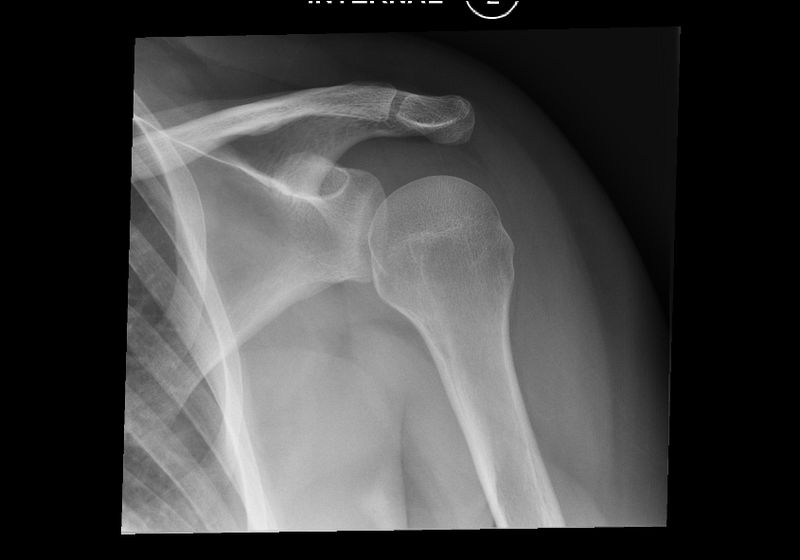Arthroscopic Bankart Repair with and without Arthroscopic Infraspinatus Remplissage in Anterior Shoulder Instability with a Hill-Sachs Defect: A Randomized Controlled Trial
MacDonald P, McRae S, Old J, Marsh J, Dubberley J, Stranges G, Koenig J, Leiter J, Mascarenhas R, Prabhakar S, Sasyniuk T, Lapner P. Journal of Shoulder and Elbow Surgery. 2021. [Epub ahead of print.] doi: 10.1016/j.jse.2020.11.013.
https://www.sciencedirect.com/science/article/abs/pii/S1058274620309599
Take-Home Message
Performing an infraspinatus remplissage with a Bankart repair leads to fewer post-operative re-dislocations while providing similar patient-reported outcomes compared to an isolated Bankart repair.
Background
A patient is likely to suffer a Bankart repair failure if they have a large Hill-Sachs lesion (impact fracture on the posterior humeral head). Hence, a surgeon may perform an infraspinatus remplissage to fill in a sizeable Hill-Sachs lesion to improve shoulder stability. However, arthroscopic remplissage increases operation time and cost. It would be beneficial to know if the remplissage procedure leads to better outcomes to justify the extra operation time and cost.
Study Goal
The authors conducted a randomized controlled trial to determine whether performing a Bankart repair with arthroscopic infraspinatus remplissage leads to better post-operative patient-reported outcomes, recurrent instability, or range of motion than an isolated Bankart repair in the presence of a Hill-Sachs defect.
Methods
The authors recruited patients 14 years or older who presented with a Hill-Sachs defect and planned to undergo an arthroscopic Bankart repair. Patients that agreed to participate in the study were randomized on the day of surgery to either undergo 1) isolated arthroscopic Bankart repair or 2) arthroscopic Bankart repair with concomitant infraspinatus remplissage. Both study participants and outcome evaluators (physical therapist/athletic therapist) were blinded to study randomization. Study participants completed patient-reported outcome measures (Western Ontario Shoulder Instability score [WOSI], American Shoulder and Elbow Surgeons shoulder score [ASES], and Simple Shoulder Test [SST]). Outcome evaluators also assessed shoulder range-of-motion preoperatively and at 3, 6, 12, and 24 months after surgery. The authors used clinical documents and patient encounters to collect complications and revision surgery data.
Results
The authors randomized 108 patients, 54 receiving isolated Bankart repair and 54 receiving Bankart repair with infraspinatus remplissage. Participants from both groups had similar improvements in patient-reported outcomes throughout the study. However, participants with remplissage had less external rotation (75°) range of motion at 12-months compared to participants without remplissage (86°), while this external range of motion did not differ at 24 months (77° vs. 77°). Fewer participants that underwent remplissage had a post-operative re-dislocation by 24 months (4%) than those with an isolated Bankart repair (18%). No one (0%) that received remplissage required revision surgery, while six participants (12%) with an isolated Bankart repair required a revision surgery.
Viewpoints
The authors found that performing infraspinatus remplissage with a Bankart repair decreases the risk of post-operative instability and revision surgery in patients with a Hill-Sachs lesion. While the surgery does decrease instability, it does not change patient-reported outcomes. It would have been interesting to compare patient satisfaction between groups, as decreased instability may lead to higher patient satisfaction despite comparable shoulder pain and function. Also, as the data is presented, the participants with an isolated Bankart repair lost range of motion from 12 to 24 months (later loss of external rotation) while participants with a concomitant infraspinatus remplissage may have lost this range of motion prior to 12 months after surgery (early loss of external rotation). Further research is necessary to explain the differences in external rotation range of motion between groups and the associated consequences. Furthermore, it would be interesting to see whether patients that receive an isolated Bankart repair have worse healing of the labral repair due to the increased external rotation range of motion at 12 months.
Clinical Implications
Surgeons may consider performing infraspinatus remplissage along with a Bankart repair for patients with significant Hill-Sachs lesions.
Questions for Discussion
How might the surrounding posterior shoulder muscles adapt to the anatomical change of the infraspinatus after remplissage? What patients would benefit from infraspinatus remplissage vs. Laterjet procedure?
Related Posts
Decision Making in Treatment after a First Time Anterior Glenohumeral Dislocation-A Delphi Approach by the Neer Circle of the American Shoulder and Elbow Surgeons
Posterior Shoulder Instability Classification, Assessment, and Management: An International Delphi Study
Returning to play in the same season following a traumatic shoulder dislocation or subluxation. Is it worth the risk?
Written by: Ryan Paul
Reviewed by: Jeffrey Driban



Remplissage has served me well for several years. We have not noticed any appreciable loss of motion and it has greatly decreased recurrence rate in our hands